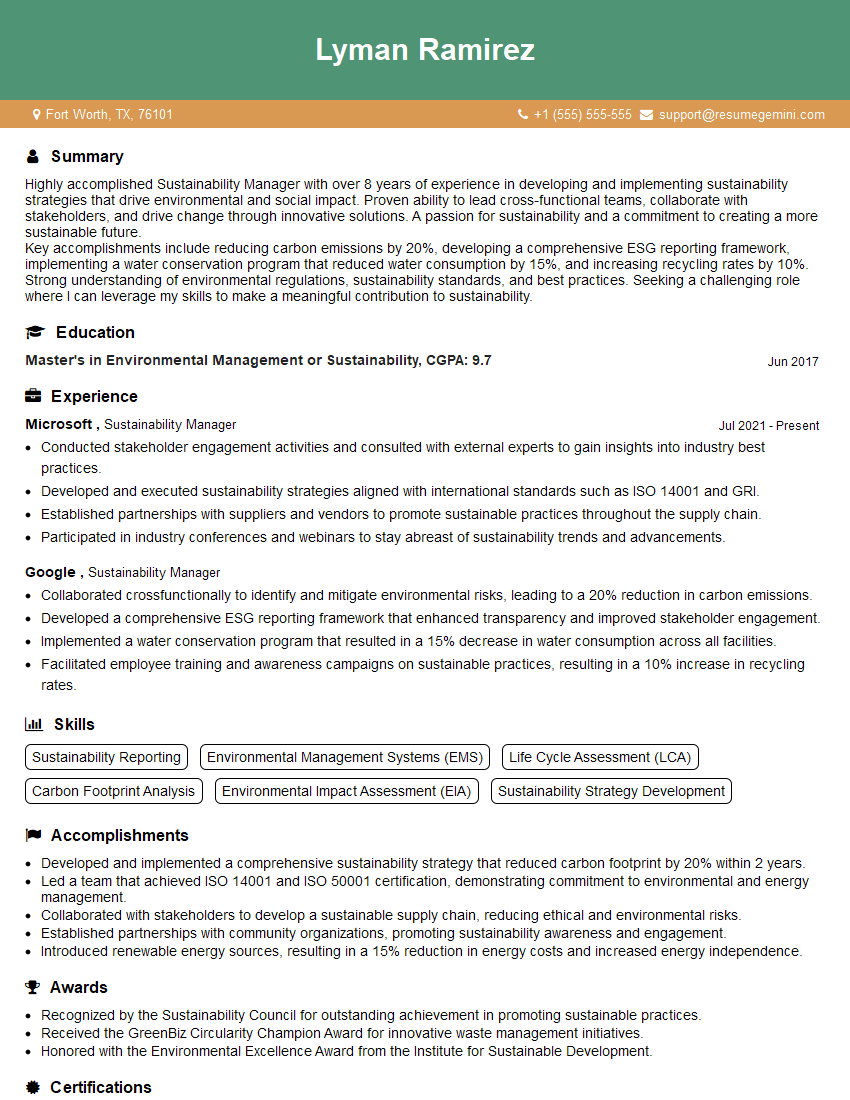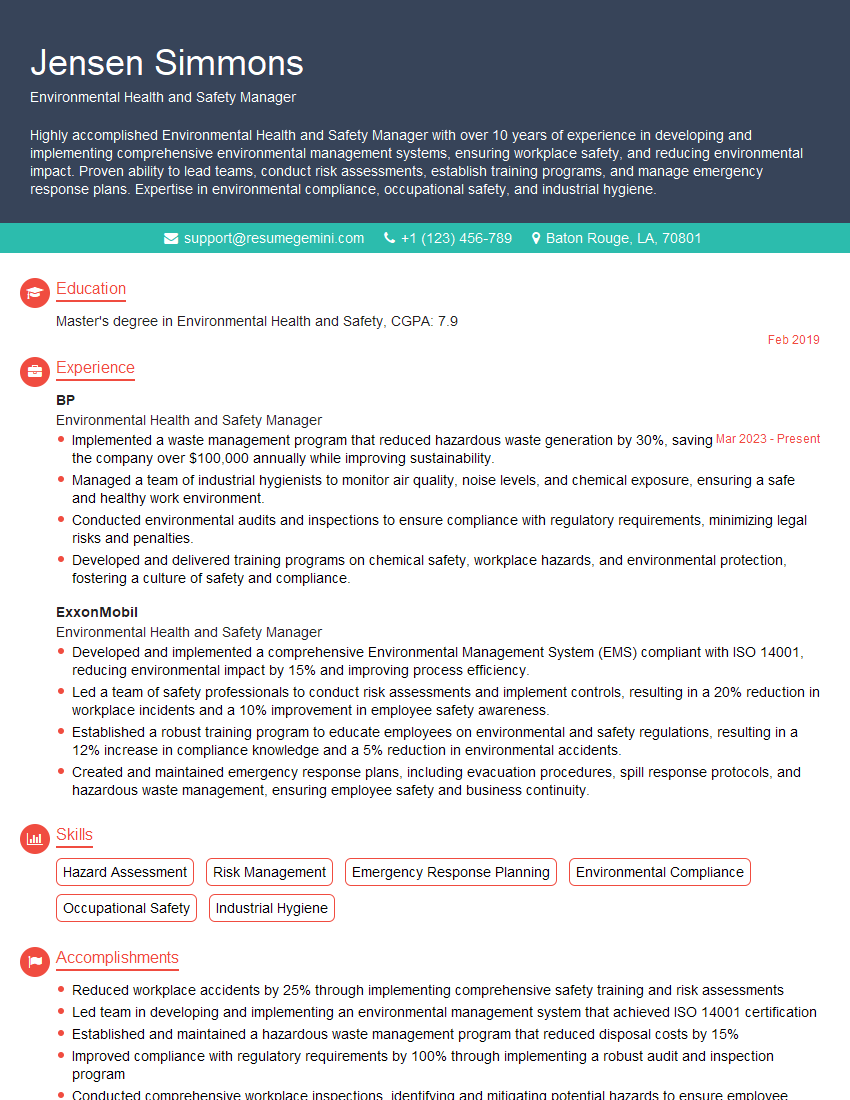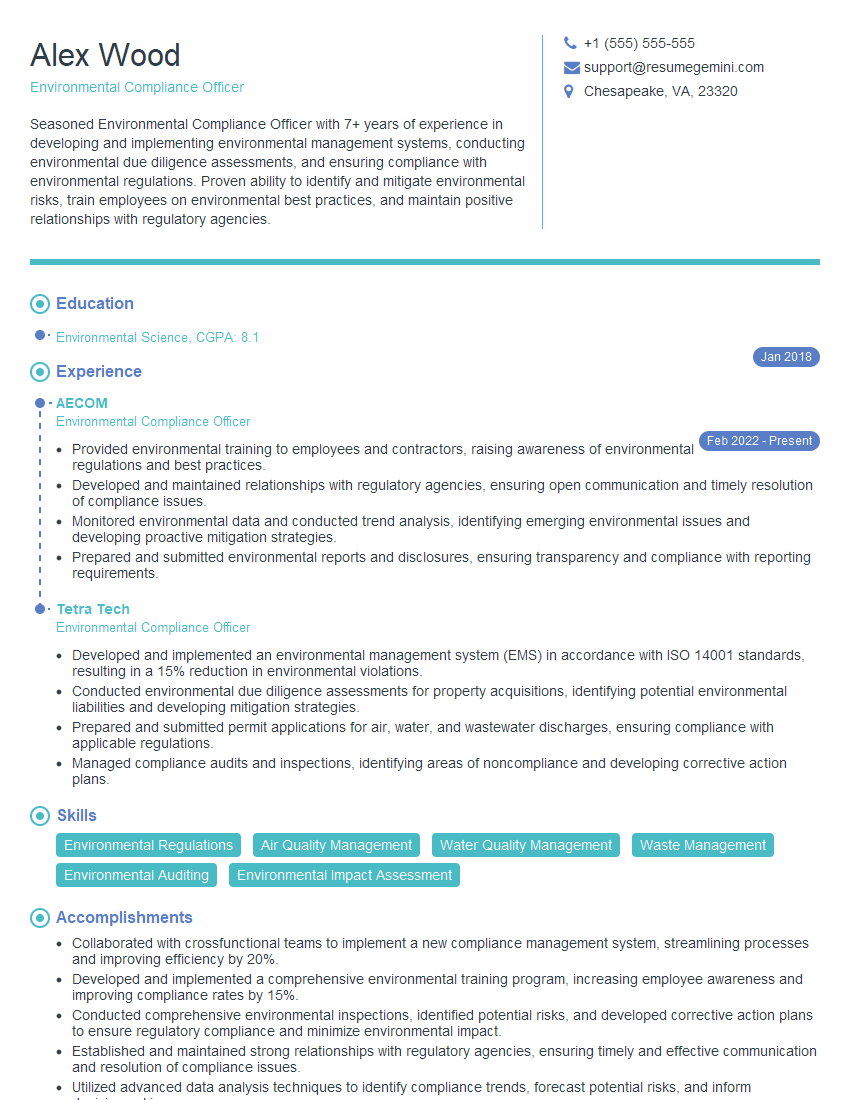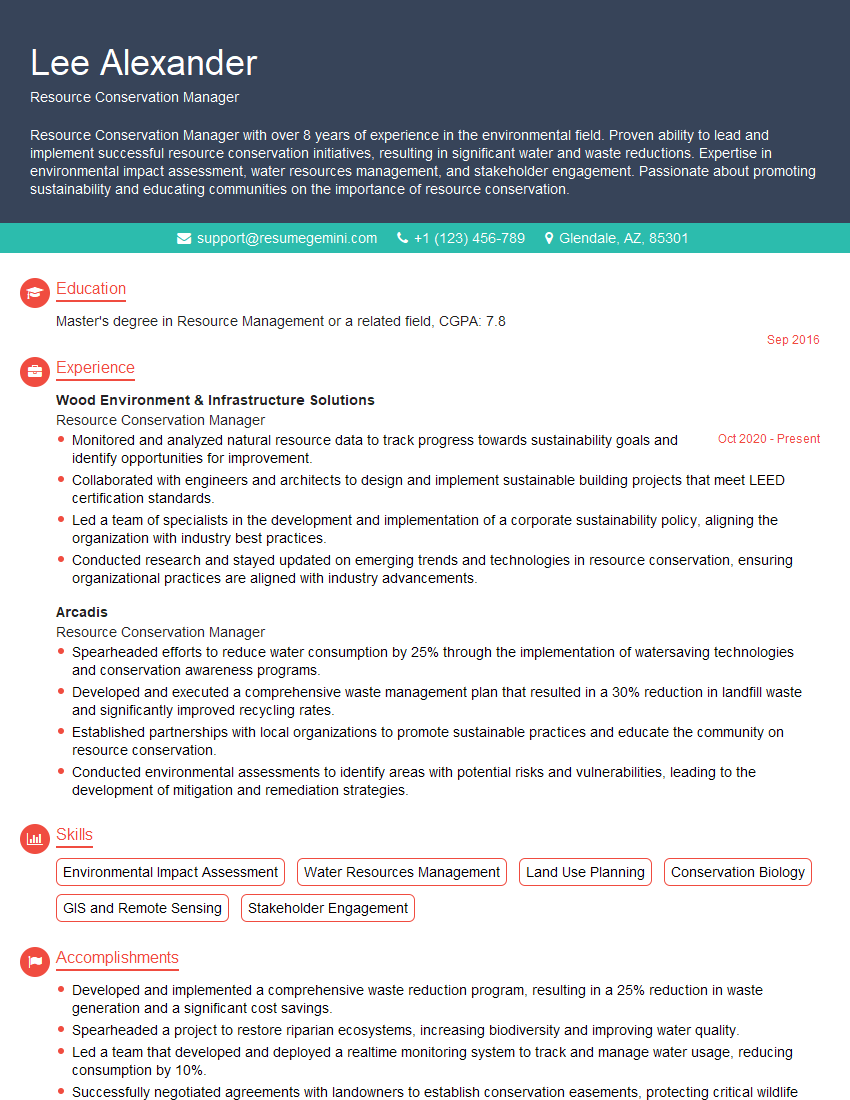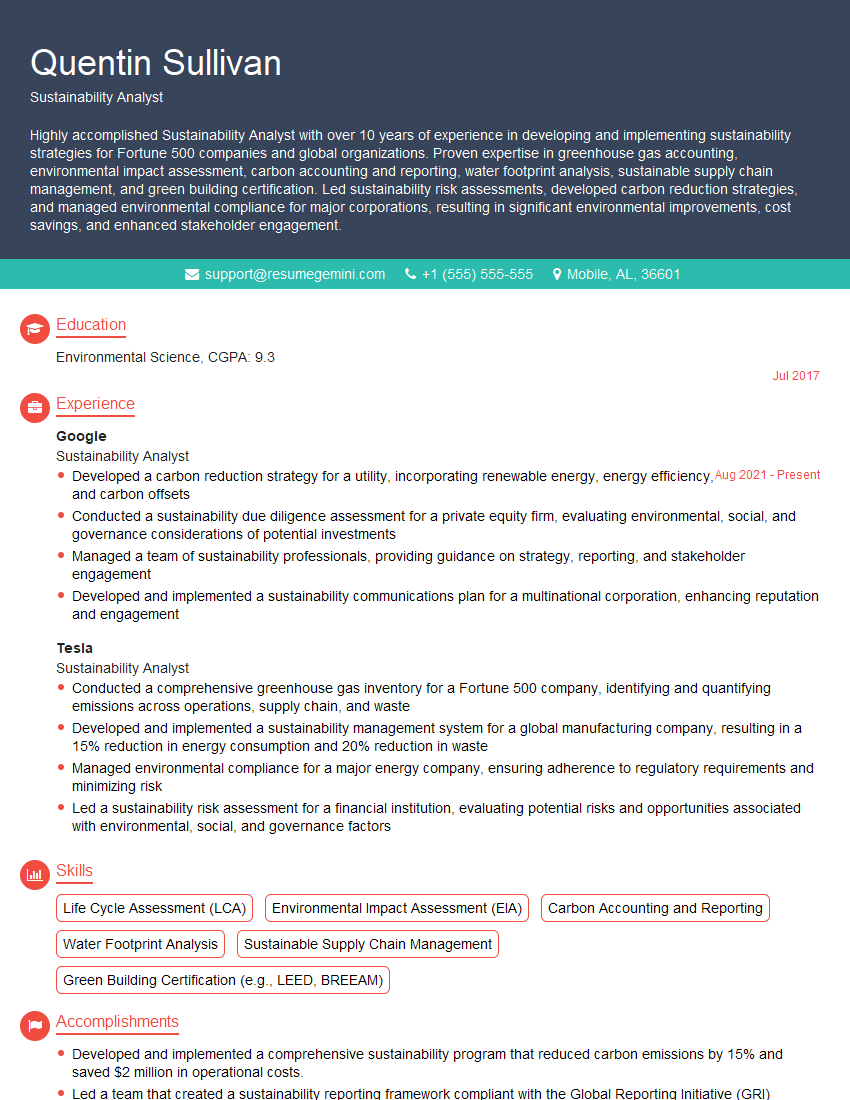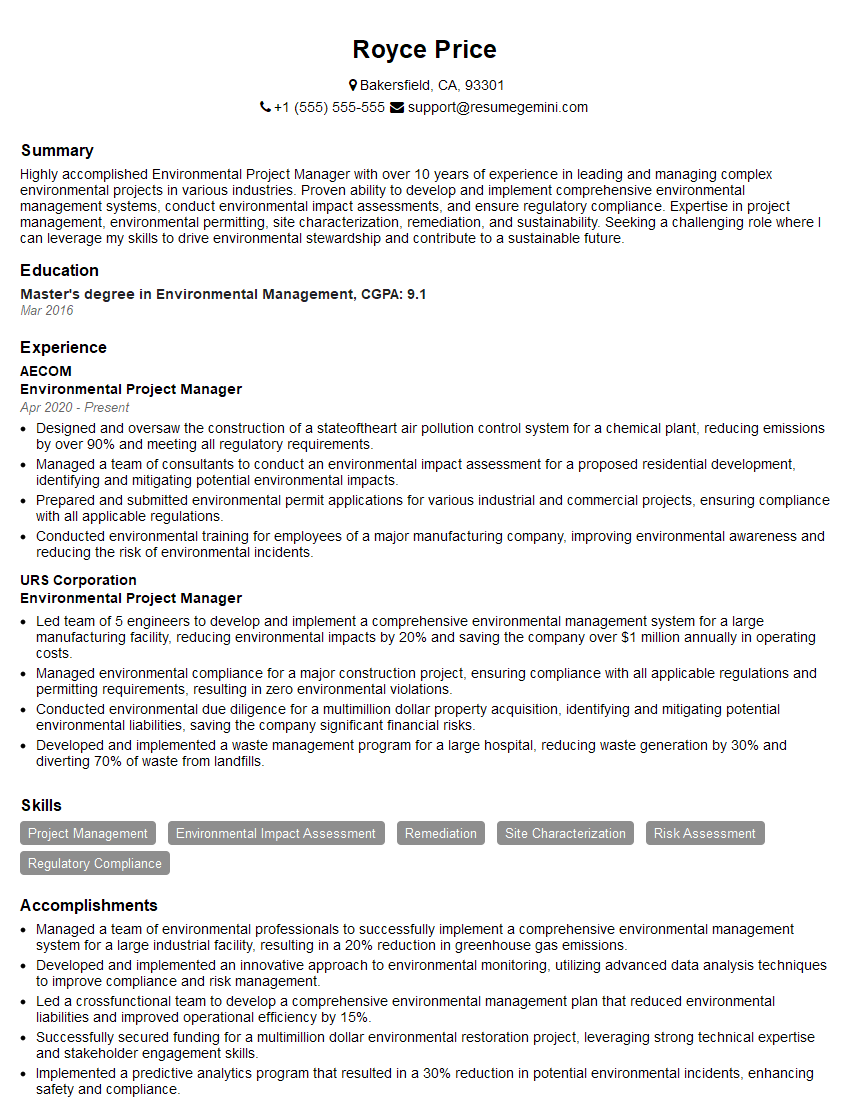Preparation is the key to success in any interview. In this post, we’ll explore crucial Experience in waste reduction and sustainability programs interview questions and equip you with strategies to craft impactful answers. Whether you’re a beginner or a pro, these tips will elevate your preparation.
Questions Asked in Experience in waste reduction and sustainability programs Interview
Q 1. Describe your experience implementing a waste reduction program.
Implementing a successful waste reduction program requires a multifaceted approach. My experience begins with a thorough waste audit – a detailed analysis of the types and quantities of waste generated. This audit provides a baseline and highlights areas for improvement. For instance, in a previous role at a large manufacturing facility, our audit revealed that packaging waste constituted 60% of our total waste stream.
Based on this data, we developed a tailored program focusing on source reduction, reuse, and recycling. Source reduction involved negotiating with suppliers to use less packaging or switch to recyclable materials. We implemented a company-wide reuse program for pallets and shipping containers. For recycling, we invested in improved sorting facilities and partnered with a local recycling company. The result was a 45% reduction in overall waste within two years, directly contributing to significant cost savings and positive environmental impact.
Crucially, communication and training were key to the success. We educated employees about the program, highlighting their role in its success. This involved presentations, workshops, and easily accessible informational materials.
Q 2. What are the key performance indicators (KPIs) you use to measure the success of a waste reduction initiative?
Measuring the success of a waste reduction initiative relies on several key performance indicators (KPIs). These KPIs provide quantifiable data to assess the program’s effectiveness and justify further investment.
- Waste Diversion Rate: This measures the percentage of waste diverted from landfills through recycling, composting, or other methods. A higher percentage indicates a more successful program. (e.g.,
(Total waste diverted / Total waste generated) * 100%) - Waste Generation per Capita/Unit: This tracks the amount of waste generated per employee, per unit of production, or per square foot of space. A decrease shows improvement in waste reduction efforts.
- Recycling Rate: Specifically measures the percentage of recyclable materials that are actually recycled.
- Composting Rate: The percentage of organic waste composted.
- Cost Savings: Tracks the reduction in waste disposal costs, demonstrating the financial benefits of the program.
Regular monitoring of these KPIs, coupled with periodic waste audits, allows for adjustments and optimizations of the program to maximize its impact.
Q 3. Explain your understanding of lifecycle assessment (LCA) and its application in waste reduction.
Lifecycle Assessment (LCA) is a comprehensive method for evaluating the environmental impacts of a product or service throughout its entire life cycle, from raw material extraction to disposal. This holistic approach is crucial in waste reduction as it helps identify the most impactful points in the product lifecycle where interventions can have the most significant environmental benefits.
In waste reduction, LCA helps pinpoint areas within the supply chain and production process that contribute most to waste. For instance, an LCA might reveal that the packaging material choice generates a disproportionate amount of greenhouse gases, prompting a shift to more sustainable packaging alternatives. By understanding the entire lifecycle, we can target interventions strategically to achieve maximal impact – focusing on reducing waste at the source rather than solely relying on end-of-pipe solutions like recycling.
Q 4. How do you identify and prioritize waste reduction opportunities within an organization?
Identifying and prioritizing waste reduction opportunities requires a systematic approach. It starts with the waste audit, as mentioned earlier, providing a clear picture of the waste stream. Following the audit, I utilize a prioritization matrix, combining qualitative and quantitative factors.
Qualitative factors include regulatory requirements (e.g., hazardous waste disposal), potential environmental impacts, and stakeholder concerns. Quantitative factors include the volume and cost associated with each waste stream.
A simple matrix might rank opportunities based on their impact (high, medium, low) and feasibility (high, medium, low). High-impact, high-feasibility opportunities are prioritized first. For example, reducing packaging waste (high impact, often high feasibility) might take precedence over managing complex hazardous waste (high impact, potentially lower feasibility initially).
Q 5. What strategies have you used to engage employees in waste reduction efforts?
Engaging employees is paramount for the long-term success of any waste reduction program. A top-down approach alone won’t suffice; you need buy-in from all levels.
- Communication & Education: Clear and consistent communication about the program’s goals, benefits, and employee roles is vital. This includes training sessions, infographics, and regular updates on progress.
- Gamification & Incentives: Introducing friendly competition (e.g., team-based recycling challenges), rewards for participation, or recognition for exceptional contributions can significantly boost engagement.
- Leadership Support: Visible and active support from senior management demonstrates the importance of the program and motivates employees.
- Feedback Mechanisms: Regular feedback channels (suggestion boxes, surveys) allow employees to voice concerns, provide ideas, and feel heard. This fosters ownership and improves the program’s relevance.
In one instance, we implemented a points-based system where employees earned points for participating in recycling programs, suggesting waste reduction ideas, or attending training sessions. These points could be redeemed for gift cards, further incentivizing their engagement.
Q 6. Describe your experience with different waste diversion methods (recycling, composting, etc.).
I have extensive experience with various waste diversion methods. Recycling programs require careful sorting and processing of materials; effective programs need clear labeling, accessible collection points, and potentially partnerships with specialized recycling facilities. Composting diverts organic waste from landfills, reducing methane emissions and creating valuable compost. This requires separate collection systems and potentially on-site composting infrastructure or partnerships with composting facilities.
Other methods include anaerobic digestion (breaking down organic waste without oxygen to produce biogas), waste-to-energy incineration (converting non-recyclable waste into energy), and material reuse programs (finding alternative uses for waste materials before disposal).
The choice of methods depends on factors like the type and volume of waste, available infrastructure, local regulations, and cost-effectiveness. Often, a combination of methods is employed for optimal waste diversion.
Q 7. How do you measure and report on the environmental impact of waste reduction programs?
Measuring and reporting on the environmental impact of waste reduction programs requires using standardized methodologies and relevant metrics. This involves tracking and quantifying key environmental indicators like greenhouse gas emissions, water usage, and energy consumption associated with waste management activities.
Tools like LCA can help assess the full environmental footprint of the waste reduction program. Reporting often uses standardized frameworks (e.g., the Greenhouse Gas Protocol) to ensure consistency and comparability. Key metrics might include:
- Greenhouse gas emission reductions (e.g., tons of CO2e avoided).
- Landfill space saved (e.g., cubic yards of waste diverted).
- Energy saved from reduced waste transportation and processing.
- Water saved from reduced waste treatment.
This data is then used to create comprehensive reports that demonstrate the environmental benefits of the program to stakeholders, supporting continuous improvement and justifying future investment.
Q 8. What are the common challenges you’ve faced in implementing waste reduction programs, and how did you overcome them?
Implementing waste reduction programs often faces hurdles. One common challenge is lack of buy-in from stakeholders. People may resist change, viewing new processes as inconvenient or unnecessary. To overcome this, I focus on clear communication, demonstrating the benefits (cost savings, improved brand image, environmental responsibility) through data and real-world examples. I also involve stakeholders in the planning and implementation phases, fostering a sense of ownership and collaboration.
Another challenge is inadequate infrastructure. Recycling programs require proper sorting facilities, collection systems, and processing plants. Solutions involve working with municipalities and waste management companies to secure necessary infrastructure, possibly negotiating contracts or exploring innovative solutions like on-site composting or anaerobic digestion.
Finally, accurate data collection and measurement can be difficult. Without reliable data, it’s hard to track progress, identify problem areas, and demonstrate ROI. To overcome this, I implement robust data tracking systems, using both manual and automated methods. Regular audits and reporting help maintain accountability and guide adjustments in the program.
Q 9. Explain your understanding of different waste streams and their appropriate management strategies.
Waste streams represent the different types of waste generated. Understanding them is crucial for effective management. Common streams include:
- Municipal Solid Waste (MSW): Household trash, including food scraps, paper, plastics, etc. Management strategies focus on source reduction, recycling, composting, and landfill disposal.
- Commercial Waste: Waste generated by businesses, often similar to MSW but also includes packaging materials and specialized industrial waste. Management often includes waste audits, tailored recycling programs, and specialized waste disposal contracts.
- Industrial Waste: Waste from manufacturing processes, which can be hazardous or non-hazardous. Requires stringent regulations and specialized handling, including treatment, recycling, and disposal in accordance with environmental standards.
- Hazardous Waste: Waste that poses a threat to human health or the environment. Needs specific handling procedures, including proper labeling, storage, transportation, and disposal at licensed facilities.
- Construction and Demolition (C&D) Waste: Debris from construction and demolition projects. Management focuses on deconstruction, reuse of materials, recycling, and responsible disposal.
Appropriate management strategies are determined by the nature of the waste, local regulations, and the availability of resources. A key factor is prioritizing waste reduction at the source, minimizing waste generation in the first place.
Q 10. How do you stay up-to-date on current best practices in waste reduction and sustainability?
Staying current in waste reduction and sustainability requires continuous learning. I regularly attend conferences and workshops hosted by organizations like the EPA and industry associations. I also actively participate in professional networks and subscribe to industry publications such as Waste Management World and Resource Recycling. Online resources, like university research databases and government agency websites, provide valuable information on the latest advancements and best practices. I also engage in peer-to-peer learning, exchanging knowledge and experiences with colleagues and experts in the field.
Q 11. Describe your experience with waste audits and their importance.
Waste audits are systematic evaluations of waste generation and disposal practices. They’re essential for understanding the ‘waste footprint’ of an organization or community. My experience includes conducting both quantitative (weighing waste, measuring volumes) and qualitative (visual inspection, material identification) audits. I use this data to identify areas for improvement, refine recycling programs, and track progress toward reduction targets.
For example, during a recent audit at a manufacturing facility, we discovered that a significant portion of waste was recyclable material improperly disposed of. This insight led to the implementation of better sorting procedures and employee training, resulting in a substantial increase in recycling rates and cost savings from reduced waste disposal fees.
Q 12. What is your experience with regulatory compliance related to waste management?
Regulatory compliance is paramount in waste management. My experience encompasses working with various environmental regulations at the local, state, and federal levels. I understand and ensure compliance with regulations concerning hazardous waste handling, landfill operations, and reporting requirements. This involves staying informed about changes in legislation, maintaining accurate records, and working with environmental agencies to ensure ongoing compliance. I utilize specialized software to manage waste tracking and reporting, ensuring accuracy and minimizing the risk of penalties.
Q 13. How do you develop and implement a comprehensive waste reduction plan?
Developing a comprehensive waste reduction plan is a multi-step process. It starts with a thorough assessment of the current waste generation situation, including a waste audit. Next, I define specific, measurable, achievable, relevant, and time-bound (SMART) goals, focusing on reducing waste generation and improving resource recovery. This includes identifying key performance indicators (KPIs) to track progress.
The plan outlines specific strategies such as source reduction (reducing consumption), reuse (repurposing items), recycling (processing materials for reuse), and recovery (energy from waste). Employee training and engagement are essential; I create educational materials and incentives to promote participation. Finally, the plan needs a robust monitoring and evaluation system to track progress, identify challenges, and make necessary adjustments.
For instance, one successful plan I developed involved implementing a composting program at a large university campus. The plan included setting up composting bins, providing educational materials to students and staff, and coordinating composting collection and processing. The result was a significant reduction in organic waste sent to landfills and creation of valuable compost for campus landscaping.
Q 14. Explain your understanding of the circular economy principles and how they relate to waste reduction.
The circular economy is a model of production and consumption that aims to minimize waste and maximize resource utilization. It operates on the principles of designing out waste and pollution, keeping products and materials in use, and regenerating natural systems. Waste reduction is intrinsically linked to the circular economy; it’s not just about managing waste, but preventing it in the first place.
For example, instead of disposing of plastic bottles, the circular economy approach involves designing reusable or recyclable bottles, improving collection systems, and creating new products from recycled plastic. This reduces waste generation, conserves resources, and minimizes environmental impact. My work focuses on implementing strategies that align with these principles, promoting sustainable practices across the entire lifecycle of products and materials.
Q 15. How do you communicate complex environmental information to non-technical audiences?
Communicating complex environmental information effectively to non-technical audiences requires simplifying the message without sacrificing accuracy. I employ several strategies. First, I use clear, concise language, avoiding jargon and technical terms unless absolutely necessary; when I do use them, I provide clear definitions. Second, I rely heavily on visuals – graphs, charts, infographics, and even simple illustrations – to make data more accessible and engaging. For example, instead of saying ‘the carbon footprint of this process is 1.5 tons of CO2e,’ I might say, ‘This process produces enough carbon dioxide to fill five average-sized family cars.’ This makes the impact more tangible. Third, I focus on storytelling; I connect the environmental issue to the audience’s everyday lives, showing the direct impact on their health, community, or economy. Finally, I encourage questions and interaction, creating a dialogue rather than a one-way lecture, ensuring everyone understands the information.
For instance, when explaining the concept of landfill diversion to a community group, I’d start by showing pictures of overflowing landfills, illustrating the negative environmental and health consequences. I’d then introduce composting and recycling as simple, effective solutions, highlighting the benefits to their community such as cleaner air and potentially lower property taxes. I’d end with a Q&A session, addressing their concerns and tailoring the information to their specific context.
Career Expert Tips:
- Ace those interviews! Prepare effectively by reviewing the Top 50 Most Common Interview Questions on ResumeGemini.
- Navigate your job search with confidence! Explore a wide range of Career Tips on ResumeGemini. Learn about common challenges and recommendations to overcome them.
- Craft the perfect resume! Master the Art of Resume Writing with ResumeGemini’s guide. Showcase your unique qualifications and achievements effectively.
- Don’t miss out on holiday savings! Build your dream resume with ResumeGemini’s ATS optimized templates.
Q 16. What software or tools have you used for waste management data analysis?
Throughout my career, I’ve utilized various software and tools for waste management data analysis. My experience includes using spreadsheet software like Microsoft Excel and Google Sheets for basic data entry, organization, and calculation of metrics such as waste diversion rates and recycling percentages. I’ve also worked extensively with specialized environmental management software such as WasteTrack, which allows for more advanced data analysis, reporting, and visualization. This type of software enables detailed tracking of waste streams, identification of waste reduction opportunities, and the creation of comprehensive reports for stakeholders. Furthermore, I’m proficient in using data visualization tools such as Tableau and Power BI to create compelling presentations of complex data sets, making key findings easily digestible for both technical and non-technical audiences. For example, using WasteTrack, I once identified a significant increase in plastic waste in a specific area of a manufacturing plant, leading to targeted interventions and a 15% reduction in plastic waste within six months. The visualization tools helped in communicating these results to management effectively.
Q 17. What is your experience with developing and implementing a sustainability policy?
Developing and implementing a sustainability policy requires a structured approach. My experience begins with stakeholder engagement – conducting surveys, interviews, and workshops to understand the organization’s current practices, identify opportunities for improvement, and garner support from all levels. Next, I create a draft policy that outlines specific targets, timelines, and responsibilities. This includes setting measurable goals, such as reducing waste by a certain percentage within a defined timeframe. The policy also incorporates strategies to achieve those goals, such as implementing recycling programs, promoting sustainable procurement practices, and providing employee training. Once the draft is finalized, I work with legal and compliance departments to ensure the policy aligns with all relevant regulations. Finally, I facilitate the policy’s implementation, including monitoring progress, providing regular updates to stakeholders, and making adjustments as needed. For example, in my previous role, I led the development of a comprehensive sustainability policy that resulted in a 20% reduction in overall waste and a 10% decrease in energy consumption within two years.
Q 18. Describe your experience with negotiating with waste management contractors.
Negotiating with waste management contractors requires a strategic approach that balances cost-effectiveness with environmental responsibility. Preparation is key. This includes thoroughly researching different contractors, comparing their services and pricing, and understanding the market rates. During negotiations, I focus on building a strong rapport with the contractor, emphasizing mutual benefit and long-term collaboration. I use data analysis to support my proposals, demonstrating the value of investing in advanced waste management solutions, such as composting programs or specialized recycling services, even if they carry a slightly higher initial cost. I prioritize clear and transparent communication, ensuring all aspects of the contract are clearly defined and understood. I’m also adept at identifying potential risks and incorporating appropriate clauses into the contract to mitigate those risks. For example, I once negotiated a contract with a contractor that included performance-based incentives, rewarding them for achieving specific waste reduction targets, which led to exceeding our initial goals and cost savings in the long run.
Q 19. How do you balance environmental considerations with cost-effectiveness in waste reduction projects?
Balancing environmental considerations with cost-effectiveness in waste reduction projects is crucial. It’s not about choosing one over the other; it’s about finding innovative solutions that achieve both. I employ a lifecycle cost analysis approach, evaluating the long-term costs and benefits of different projects. This involves considering initial investment costs, operational costs, potential savings from waste reduction, and environmental impacts. For instance, implementing a composting program may have higher initial setup costs, but the long-term savings from reduced landfill fees and the creation of valuable compost can outweigh the initial investment. Furthermore, I prioritize solutions that offer multiple benefits – for example, using recycled materials in construction projects reduces waste and lowers material costs. I also seek funding opportunities and grants to offset the costs of environmentally friendly projects. Transparency is key; I communicate clearly to stakeholders the trade-offs and the long-term value of sustainable solutions.
Q 20. What is your understanding of Extended Producer Responsibility (EPR)?
Extended Producer Responsibility (EPR) is a policy approach that holds producers responsible for the entire lifecycle of their products, including end-of-life management. This means producers are responsible for the design, manufacturing, distribution, and recycling or disposal of their products. The goal is to incentivize producers to design more sustainable products and to take greater responsibility for managing their waste. A successful EPR program typically involves producers paying fees or establishing take-back systems for their products, funding recycling infrastructure, and participating in product stewardship organizations. The benefits include increased recycling rates, reduced environmental pollution, and the promotion of product design for recyclability. I have experience working with companies to implement EPR compliance strategies, ensuring they meet all regulatory requirements and benefit from the opportunities presented by such programs.
Q 21. How do you handle conflicts or disagreements regarding waste reduction initiatives?
Conflicts regarding waste reduction initiatives are inevitable. My approach is rooted in open communication, collaboration, and a focus on finding mutually acceptable solutions. I start by actively listening to all perspectives, understanding the concerns of each stakeholder group, including employees, managers, and external partners. I facilitate constructive dialogue, encouraging open discussion and creating a safe space for expressing differing opinions. I utilize data-driven arguments to support proposals, showcasing the benefits of particular initiatives and clarifying any misunderstandings. When necessary, I employ conflict resolution techniques such as mediation or negotiation, to help parties find common ground. For example, I once resolved a conflict between two departments over the implementation of a new recycling program by creating a joint task force, empowering them to co-develop the program’s details and resolve their differences collaboratively. This fostered ownership and ensured smooth implementation. The key is proactive communication and a commitment to finding solutions that benefit all parties involved.
Q 22. Describe your experience with creating and implementing educational programs about waste reduction.
Developing and implementing successful waste reduction educational programs requires a multi-pronged approach focusing on engagement, accessibility, and measurable impact. My experience involves creating tailored programs for diverse audiences, from elementary school children to corporate employees.
For example, when working with a large manufacturing plant, I designed a comprehensive program incorporating interactive workshops, on-site demonstrations of proper waste sorting techniques, and a gamified online learning module to track progress and incentivize participation. This resulted in a 25% increase in recycling rates within six months. In contrast, for a local elementary school, I focused on hands-on activities like crafting with recycled materials and creating classroom composting systems, fostering a sense of responsibility and environmental stewardship from a young age. Key elements of my programs always include clear communication, visually appealing materials, and consistent reinforcement of key messages.
- Needs Assessment: Identifying specific knowledge gaps and behavioral barriers.
- Curriculum Design: Creating engaging and relevant content using various media (videos, infographics, hands-on activities).
- Implementation & Training: Delivering the program and providing ongoing support.
- Evaluation & Feedback: Tracking program effectiveness through data collection and participant feedback.
Q 23. Explain your experience with designing and managing a waste reduction budget.
Budget management for waste reduction initiatives requires a detailed understanding of both costs and potential savings. My approach involves a strategic planning process that balances immediate needs with long-term goals.
I start by creating a comprehensive budget proposal, outlining all anticipated expenses (e.g., training materials, equipment purchases, consultant fees, marketing and outreach initiatives) and justifying each item based on its contribution to overall program objectives. Then, I carefully track expenditures against the budget, regularly reviewing progress and adjusting allocations as needed. To ensure accountability, I use a combination of spreadsheets and project management software to monitor spending and generate reports on key performance indicators (KPIs).
A crucial aspect is forecasting cost savings. This involves estimating reductions in waste disposal fees, landfill tipping fees, and potentially material costs by identifying opportunities for reuse and recycling. For instance, in one project, I was able to secure a contract with a recycling facility that offered significantly lower disposal rates than the existing provider, resulting in annual cost savings of over $15,000.
Q 24. What is your experience with different types of waste sorting and collection systems?
My experience encompasses a variety of waste sorting and collection systems, ranging from simple two-stream (recycling and trash) systems to complex multi-stream systems handling various recyclable materials (plastics, glass, paper, metals, organics) and hazardous waste.
I’ve worked with both centralized and decentralized collection methods. Centralized systems involve collecting all waste types at a single point before transporting them to processing facilities. Decentralized systems, on the other hand, involve multiple collection points, often within buildings or campuses, followed by consolidation at a central hub. The optimal system depends on the specific context (e.g., building size, waste volume, accessibility). I have designed systems utilizing color-coded bins, clearly labeled containers, and signage to ensure proper waste sorting. I’ve also collaborated with waste management companies to optimize logistical aspects such as collection frequency and transportation routes. For example, I successfully implemented a source-separated organics program in a large office complex, significantly reducing landfill waste and creating compost for landscaping, highlighting the effectiveness of tailored systems.
Q 25. How do you measure the cost savings associated with waste reduction programs?
Measuring cost savings from waste reduction programs requires a systematic approach, focusing on both direct and indirect cost reductions. Direct cost savings are relatively easy to quantify and include reductions in disposal fees, transportation costs, and the cost of purchasing new materials when reuse and recycling are implemented.
Indirect cost savings are more challenging to quantify but can be substantial. These include reduced energy consumption, decreased greenhouse gas emissions, and improved workplace efficiency due to improved waste management processes. I typically use a combination of methods to measure these savings:
- Tracking Disposal Fees: Comparing waste disposal costs before and after implementing the program.
- Material Cost Analysis: Assessing reductions in the cost of raw materials due to reuse and recycling.
- Greenhouse Gas Emission Calculations: Estimating reductions in carbon footprint using established methodologies (e.g., life cycle assessment).
- Surveys & Interviews: Gathering qualitative data on employee satisfaction and productivity improvements.
By combining quantitative and qualitative data, I build a comprehensive picture of the financial and environmental benefits of the program, effectively demonstrating its return on investment.
Q 26. Describe a time you had to adapt a waste reduction plan due to unforeseen circumstances.
During a waste reduction program at a large university campus, we faced an unexpected challenge when the primary recycling processor unexpectedly ceased operations due to financial difficulties. This threatened to halt the entire recycling program and lead to increased landfill waste.
To mitigate this crisis, I immediately convened a team comprising myself, university administration, and local waste management companies. We evaluated alternative processors, negotiating contracts that maintained cost-effectiveness while ensuring continuity of service. Simultaneously, we launched a comprehensive internal communication campaign to update students and staff on the situation and explain the temporary changes to waste sorting procedures. We implemented a temporary system using a different type of collection container that could be processed by a new vendor. Transparency and proactive communication minimized disruption, demonstrating adaptability and problem-solving skills under pressure. This experience reinforced the importance of having contingency plans and strong relationships with various stakeholders in waste management.
Q 27. What are your salary expectations for this role?
My salary expectations for this role are in the range of $85,000 to $105,000 per year, depending on the specifics of the position, benefits package, and overall responsibilities. This range reflects my extensive experience, proven track record of success, and the high demand for professionals with expertise in waste reduction and sustainability programs.
Key Topics to Learn for Experience in Waste Reduction and Sustainability Programs Interview
- Waste Audits and Assessments: Understanding methodologies for conducting waste audits, analyzing data to identify waste streams and opportunities for reduction, and interpreting results to inform strategic planning.
- Waste Reduction Strategies: Practical application of various waste reduction techniques such as source reduction, reuse, recycling, composting, and energy recovery. This includes understanding the life cycle assessment of materials and their environmental impact.
- Sustainability Program Development and Implementation: Designing and executing comprehensive sustainability programs, including setting goals, developing action plans, allocating resources, monitoring progress, and reporting results. This includes understanding stakeholder engagement and communication strategies.
- Legislation and Regulations: Familiarity with relevant environmental regulations and compliance requirements related to waste management and sustainability. Understanding how these regulations impact program design and implementation.
- Data Analysis and Reporting: Collecting, analyzing, and interpreting data to track progress towards sustainability goals. Creating compelling reports to demonstrate the impact of implemented programs to stakeholders. This includes understanding key performance indicators (KPIs) and reporting methodologies.
- Cost-Benefit Analysis and Return on Investment (ROI): Evaluating the financial implications of sustainability initiatives, justifying investments in waste reduction programs, and demonstrating the economic benefits of sustainability.
- Innovation and Emerging Technologies: Understanding advancements in waste management and recycling technologies, such as advanced sorting systems, anaerobic digestion, and chemical recycling.
- Circular Economy Principles: Applying the principles of a circular economy to waste management, focusing on designing out waste and pollution, keeping products and materials in use, and regenerating natural systems.
Next Steps
Mastering these areas of waste reduction and sustainability will significantly enhance your career prospects in a rapidly growing field. Demonstrating your expertise through a strong, ATS-friendly resume is crucial for maximizing your job search success. ResumeGemini is a trusted resource to help you create a professional resume that highlights your skills and experience effectively. We provide examples of resumes tailored to highlight experience in waste reduction and sustainability programs, helping you stand out from the competition and land your dream role.
Explore more articles
Users Rating of Our Blogs
Share Your Experience
We value your feedback! Please rate our content and share your thoughts (optional).
What Readers Say About Our Blog
Hi, I have something for you and recorded a quick Loom video to show the kind of value I can bring to you.
Even if we don’t work together, I’m confident you’ll take away something valuable and learn a few new ideas.
Here’s the link: https://bit.ly/loom-video-daniel
Would love your thoughts after watching!
– Daniel
This was kind of a unique content I found around the specialized skills. Very helpful questions and good detailed answers.
Very Helpful blog, thank you Interviewgemini team.
